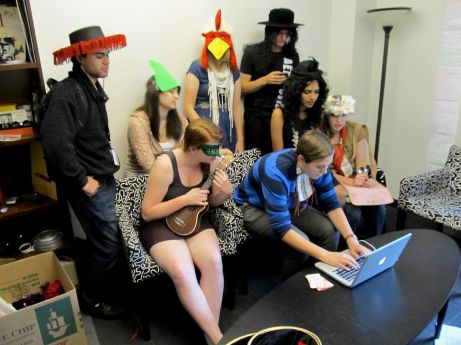"Reality Ends Here - Season 3" Postmortem
In this postmortem, puzzle designer and game runner Kevin Wong reflects on the successes and problems encountered by the award-winning Reality Ends Here ARG at the USC School of Cinematic Arts

This article was originally posted to my blog at kevinjameswong.com
105 days, 191 players, 251 projects, 648 cards, over 300,000 points.
After nearly a year of work, the third season of the Reality Ends Here game has finally come to a close. I joined the project as a narrative/puzzle designer back in January by taking the ARG practicum class, and the game has come a long way since its cloudy inception. Past iterations of the game have been incredibly successful, having won the 2012 Indiecade Impact Award and being cited by Extra Credits in their episode about games in education. The game helped me take my first steps forward into the most creative and prolific period of my life when I played it, this year’s iteration is a bit different, the air of mystery surrounding the game isn’t quite as pronounced due to a multitude of reasons, inhibiting the desired feeling of anarchic excitement critical to the game’s success.

A typical Reality Ends Here justification
Nonetheless, I’m incredibly proud of our work with this game. Reality Ends Here – Season 3 has served its purpose, connecting its players into a diverse network of friends, mentors, and rivals, changing how they go about their everyday lives at USC, bringing any given idea into oft-amazing fruition. Reality Ends Here was my favorite game of 2012, and I am incredibly grateful to have been granted the blessing of working on its next season. I hope that I have been able to create an awesome first-semester experience for this year’s Freshmen, and hope to seem them step forward into fruitful, prolific careers of courageous integrity.
WHAT WENT RIGHT
1. PROLIFIC CORE PLAYERS
In terms of players to content created, the third season of Reality Ends Here was one the most successful ever run. Over the course of eighteen weeks, over 250 projects were created ranging from the punk, to the postmodern, to the absurd. This is impressive given that the 2012 Season had approximately 196 deals and the 2011 Season had 112. The core group of players consistently put effort into their work, creating roughly a new project each week. Familiar faces were seen regularly in the Game Office, allowing us to form a relationship with our players and understand them and their work on a deeper level. A greater variety of non-film Maker cards was included in the 2013 deck, allowing players to do work in different mediums such as derives, manifestos, and zines, marked by the largest number of nondigital games to have been seen in any version ofReality. Cross compatibility with the Annenberg version of the game allowed players to explore themes and mediums left untouched in film school, expanding their horizons substantially. One of the most notable additions was a “Solo Project” Special Card, which would bestow points for working alone on a project. While this falls slightly outside of the intended aesthetic of friendly cooperation, this was a heavily used card which players enjoyed playing with.
2. RABBIT-HOLE & “ARG-SAUCE”
Outside of trading cards and “leveling up” by passing predesignated point thresholds, solving complex puzzles

Tim Taylor was an accidental element of a puzzle that evolved into a meme in later deals
was the primary means for players to get new cards. While nothing as complex or sophisticated as Season 2′s Minecraftworld emerged from this season, the seven puzzles that we did deploy sparked players imaginations and had them exploring the campus, scouring it for its secrets. Every little indication or hint that we would drop our players would quickly pick up, analyzing them and seeking meaning in the clues. One puzzle had players rearrange a set of directions on basis of Oscar History to form a map that would lead them to a secret card stash. Another had players seek out a secret phone number that they would call to receive a string of numbers corresponding to a hidden book in the library, where they would find their cards. These challenges were quite complex and were rewarded with enough cards to reenergize a players bank and put them ahead in the game. This could be disconcerting though, as the biweekly frequency of these challenges might have caused players to construe these scavenger hunts as a core mechanic of the game.
Aside from the scavenger hunts, the ”Rabbit Hole” sequence, the initial week of Reality where the existence of the game is kept secret and players are challenged to discover it, was incredibly successful, if perhaps due in part to greater awareness of the game’s existence. Nonetheless, we had over eighty players signed up in the first day of the game, and the game’s first deal was submitted within the first hour of the Game Office’s opening.
3. QUALITY OF WORK
While power gaming and forced-pointsing did indeed happen with this season of the game, all players put substantial effort into almost all of their deals. Players experimented with unusual mediums that required substantial effort to pull off, such as animated shorts, Kickstarter Projects, drawn-on-films, and faux New Wave. Video-based deals were substantially longer, the longest reaching upwards of seventeen minutes. Projects made in the were submitted to festivals, and were screened in CNTV 101. One team developed a particularly distinct punk aesthetic, dealing with queer themes in all of their diverse work. Another player wrote a full season of full-length courtroom dramas. The most notable project to have emerged from the game is the UNI School of Bollywood Arts, a transmedia franchise taking place in an alternate universe where India has colonized Hollywood, resulting in a film school dedicated to Bollywood film. The franchise consisted of a successful crowdfunding campaign, a series bible, and a short film, created by a large team with a pronounced structure, complete with auditions, casting calls, and dedicated roles, resulting in likely the largest and most complex project to have ever emerged from the game.
4. BALANCING & NEW MECHANICS
All of Reality‘s Green Maker Cards were redesigned to accommodate special challenges that could be completed for point bonuses, incentivizing increased effort and higher quality work. This resulted in better, more complex deals that were not necessarily “thrown together”. Players had a lot of fun attempting to fulfill these optional objectives and played more competitively.
One of the most controversial new mechanics was the “Scan Card”, a mysterious card which could only be acquired by solving a puzzle. The Scan Card had a QR-code, which, if played, rolled a dice and applied a random effect to the deal it was applied to. One play may double the points of a deal or win players additional cards, other plays could destroy the Scan card, reward other players points, or delay the deal’s publication to the next week, essentially making the choice of playing the card one of high risk. Players initially played the Scan Card with gusto until Logan Austin rolled the “Self-Destruct” effect, forcing him to tear apart the card. All players used the Scan Card very conservatively thereafter.
5. MINIMAL EMBEDDED NARRATIVE
The original design of Season 3 had an underlying narrative to it, aligning it with other traditional ARGs, which would be delivered through notes left by an opponent to the Reality Committee that players would discover at the end of each puzzle sequence. This entire element of the game was cut, as interacting with embedded narrative is an aesthetic of consumption, which contradicts the game’s intended goal of promoting creation, distancing players from the game’s goal of fostering creativity and collaboration within its player base. Instead, a similar narrative arc appeared emergently as previous years players would interfere with the game, granting players overpowered cards intended to be removed from the system by putting them through unusual and difficult challenges.
Nonetheless, the embedded narrative elements survived and were included into the game enhanced player’s experiences substantially. The first element was “Vintage Cards”, cards that were used in the game’s previous decades that we found and included in the game as rewards for solving puzzles. These Vintage Cards could be played like any other game card, and alluded to the game’s history of being played by students as an underground subculture.
WHAT WENT WRONG
1. DROPOFF
While the player base for Season 3 is the largest it has ever been, the drop in active players was more pronounced than we expected. The game started with a group of nearly 170 players, but dropped off substantially as the semester ramped up, going down to twenty players and ending with a core group of roughly sixteen players. While this core group was indeed prolific, it is surprising to see how drastically the number of players dropped off after the first few weeks. Substantial drop-offs have been characteristic of previous seasons of the game given the plethora of other commitments students have, ranging from fraternity commitments, to midterms, clubs, and non-game related projects, the players that do survive and remain committed and passionate about DIY-media making go on to create the game’s best content. Nonetheless, when designing future iterations of the game, Reality Game Runners should take into consideration the reasons that this phenomenon takes place and take measures to keep players engaged with playing and project-creation without compromising the game’s core aesthetics of aggressive, creative competition and self-motivated, creative agency.
2. “POINTSING”
“Pointsing” was a term that players coined to describe the forced integration of loosely-justified cards into deals in an attempt to maximize the score-value of an individual project or any other behavior that may be construed as “pushing the rules” of the game in order to maximize the score of a deal. While this behavior did create interesting dramatics and make for more competitive, aggressive play from other players, I am concerned about the effect that this behavior might have on other players. Richard Bartle’s categorization of players of MUDs posits that the behavior of different kinds of players in a game space can substantially affect the game experience for other players. “Power-gamers” that aggressively balance and min-max their builds and play styles can potentially overpower other players and make them feel impotent and powerless, disincentivizing their continued play given the knowledge that they could not necessarily match up points-wise against the other teams. While the negative feedback system integrated into the cards with the “depletion” mechanic reduced each card’s value with each consecutive use, this behavior was still present. One thing that could be done to address this issue is to better communicate the fact that the Reality Committee pick weekly winners in terms of both points and quality.
3. UNIMPLEMENTED MECHANICS & CONTENT
A plethora of mechanics, rules, and content was created for the game during the Spring Practicum. Only a fraction of that content made it into the final iteration of the season. Many of the cut elements reasonably improved or preserved the experience of the game, such as the removal of an embedded narrative, which would have detracted from the exploratory, self-motivated aesthetic critical to the game’s success. Nonetheless, out of oversight or lack of time and resources, we had to scale back on many things, such as the complexity of each of the puzzles. One of the game’s first puzzles involved cracking open a hidden safe to discover a secret cache of cards. This puzzle was scaled back due to time and budget constraints to feature only a suitcase and a combo-lock. The collectable “audio-diaries” alluding to the stories and experiences of past students and alumni of SCA were cut entirely, instead, we included artifacts from the game’s past: a collection of “vintage cards” from prior decades runs of the game, a grainy image of the Bullpen as it existed in the forties, a blurry photograph from last year’s Wrap Party.
Perhaps the mechanic that we most unfortunately left out was the inclusion of “weekly challenges” that players can undertake for special bonuses. Shoot a deal using only a cell-phone camera, shoot on 35mm film, collaborate with someone you’ve never worked with before. These special challenges would have shook up the game substantially and kept players on their toes, constantly experimenting and trying out new methods of media-making.
4. CHAOTIC SCHEDULING
Season 3 of Reality Ends Here was run entirely by three people with the intermittent involvement of the Reality Committee. Esteban Fajardo and I were Game Runners and Simon Wiscombe was Game Master. Esteban and I both have full eighteen-unit class schedules and are working on Advanced Game Projects, limiting our availability in the office during the week’s peak periods and ability to create complex, involving challenges that multiple groups of players can engage with. One particularly rough scheduling fiasco occurred during a “Double Points Week”, wherein the points value of all submitted deals is doubled, incentivizing players to create and submit as many projects as they can during that week. I was running playtests for an Intermediate Games Project as part of my Usability Testing Class on the Friday of that week, preventing me from being available at the Game Office on that day, forcing me to ask last year’s Game Runners to substitute for me and run justifications.
5. TECHNOLOGY
We revamped the entire Reality Ends Here website in order to streamline the process of submitting and justifying deals, and for the first few weeks of the game, the new site served its purpose admirably and effectively. But past the mid-game and escalating throughout the entirety of the late-game, the website started exhibiting serious issues. Entire submissions were lost and had to be redone again, the site would lag and stutter at the most inappropriate times, players who changed their account names found themselves with multiple accounts, each with its own score on the leaderboard, and players would find themselves inexplicably in the lead with tens of thousands of points, or suddenly lose all their points. While the site is effective and usable from the front-end, it would be important to look into improving the sites stability in the next season of Reality Ends Here.
CREDITS
Designed by:
The Reality Committee
Season 3 Game Master:
Simon Wiscombe
Season 3 Game Runners:
Kevin Wong and Esteban Fajardo
Season 3 Backup Game Runners:
Michael Effenberger, Will Cherry, Althea Capra
Download the Game Master’s Manual at
http://realitycommittee.org
Read more about:
BlogsAbout the Author(s)
You May Also Like







.jpeg?width=700&auto=webp&quality=80&disable=upscale)








